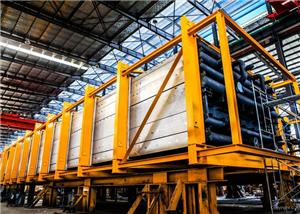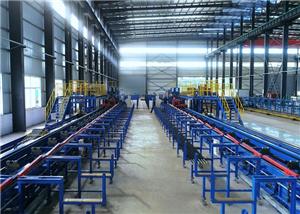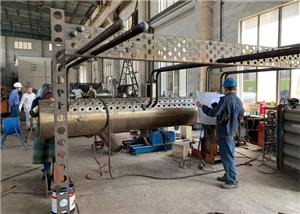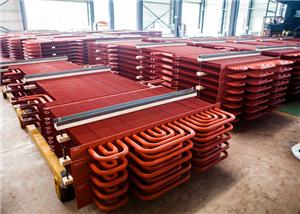-
1.ประเภทความร้อนเหลือทิ้งที่กู้คืนจากหม้อไอน้ำความร้อนเหลือทิ้งคืออะไร
The principle of waste heat boiler is that the fuel oil, gas and coal are burned to produce the heat emission of high-temperature flue gas. The high-temperature flue gas first enters the furnace chamber, then enters the waste heat recovery device of the front smoke box, then enters the pyrotechnics pipe, and finally enters the waste heat recovery device of the flue pipe of the back smoke box. The high-temperature flue gas turns into low-temperature flue gas and is discharged into the atmosphere through the stack. 1. High temperature flue gas waste heat: it is a common form, its characteristics are large output, concentrated production point, strong continuity, easy to recover and use, heat absorb accounted for 40~50% of the total heat, the waste heat boiler recovery heat, can be used in production or daily life heat and power generation. 2. Residual heat from high temperature furnace slag, 3. High temperature product waste heat: such as steel billet, high temperature forging part etc, 4. The residual heat of combustible waste gas and liquid waste, 5. Residual heat of chemical reaction, 6. Residual heat of cooling medium, 7. Waste heat from condensation water.
-
2.ทำไม HRSGs ใช้หลอดครีบ?
เหตุผลที่ใช้หลอดครีบใน HRSG: เพื่อปรับปรุงประสิทธิภาพของหม้อไอน้ำความร้อนเหลือทิ้งจะต้องลดความแตกต่างของอุณหภูมิระหว่างอุณหภูมิควันและอุณหภูมิไอน้ำหม้อไอน้ำ มีพื้นที่ความต้านทานและอุณหภูมิที่แตกต่างกัน พื้นที่ความร้อนของหม้อไอน้ำความร้อนเหลือทิ้งจะเพิ่มขึ้น เพื่อลดการสูญเสียความต้านทานการไหลพื้นที่การไหลสามารถเพิ่มขึ้นและความเร็วการไหลจะลดลง อย่างไรก็ตามการไหลความเร็วต่ำนั้นถูกผูกไว้เพื่อลดประสิทธิภาพการถ่ายเทความร้อน เพื่อเพิ่มพื้นที่การถ่ายเทความร้อน ในทางกลับกันพื้นที่ของ HRSG จะเพิ่มขึ้นเป็นอนันต์ การใช้ท่อครีบเกลียวสามารถมั่นใจได้ว่าพื้นที่การถ่ายเทความร้อนเพียงพอเพิ่มการถ่ายเทความร้อนและสามารถลดความต้านทานก๊าซไอเสีย!
-
3.เคล็ดลับหม้อไอน้ำ
1. The drum is connected by a riser and a downcomer to form a natural circulation loop.Upper drum is filled with water and steam mixture from circulation loop,normally there will be water steam seperating device and feeding water distribution pipe.In order to improve the quality of boiler water some boilers are also equipped with continuous sewage pipe and dosing pipe. There is a regular sewage discharge device in the lower drum. On the outer wall of the upper boiler drum of steam boiler, there are also flanged short pipes connecting the main steam pipe and the secondary steam pipe and flanges and short pipes connecting the continuous water level gauge, pressure gauge, safety valve and other accessories. There is a regular blowdown device for discharging sediment in the lower boiler drum. 2. For larger capacity boilers, simply using natural separation of steam and water can no longer meet the requirements, need to install a seperating device inside upper drum. 3. The water-cooled wall tube is usually a no.10 or no.20 seamless steel tube with an outer diameter of 51~76mm and a wall thickness of 3.5~6.0mm. The distance between the center of the tube is generally 1.25~2 times of the outer diameter of the tube.Both finned tubes and bare tubes. 4. Water - cooled walls are generally fixed on the upper, the lower can be free expansion. 5. The function of steam superheater is to heat the saturated steam drawn out of the upper drum to a certain temperature of the superheated steam. Industrial steam is mostly saturated steam, so normally general boiler are not equipped with steam superheater. A steam superheater is installed in the boiler only if the production steam requires a higher temperature and does not require an increase in steam pressure, or if superheated steam is required in order to reduce condensation losses during steam transmission. In industrial boilers, the temperature of superheated steam is 250℃ and 350℃ for the boilers with working pressure of 1.25MPa, and 350℃ for the boilers with working pressure of 1.6MPa.
-
4.ความรู้พื้นฐานของหม้อไอน้ำ
หม้อไอน้ำหมายถึงอุปกรณ์ที่ใช้พลังงานความร้อนที่ปล่อยออกมาจากการเผาไหม้เชื้อเพลิงหรือพลังงานความร้อนอื่น ๆ ไปยังน้ำร้อนหรือสื่อการทำงานอื่น ๆ เพื่อผลิตไอน้ำหรือน้ำร้อนด้วยพารามิเตอร์ที่ระบุ (อุณหภูมิความดัน) และคุณภาพ การจำแนกประเภทของหม้อไอน้ำ: การใช้งาน: โรงไฟฟ้าหม้อไอน้ำ, หม้อไอน้ำอุตสาหกรรมไอน้ำ: หม้อไอน้ำความดันที่วิกฤตยิ่งยวด, หม้อไอน้ำความดันใต้วิกฤต, หม้อไอน้ำแรงดันสูงพิเศษ, หม้อไอน้ำแรงดันสูง, หม้อไอน้ำแรงดันต่ำ ความจุการระเหย: ขนาดใหญ่, ขนาดกลาง, ขนาดเล็ก สื่อ: หม้อไอน้ำ, หม้อต้มน้ำร้อน, หม้อไอน้ำที่ให้ความร้อนอินทรีย์แหล่งความร้อน: หม้อไอน้ำถ่านหิน, หม้อไอน้ำที่ใช้น้ำมันเป็นเชื้อเพลิง, หม้อไอน้ำที่ใช้ก๊าซเป็นเชื้อเพลิง, หม้อไอน้ำร้อนเสีย, หม้อไอน้ำไฟฟ้า โครงสร้าง: เปลือกหม้อไอน้ำหม้อไอน้ำท่อ




